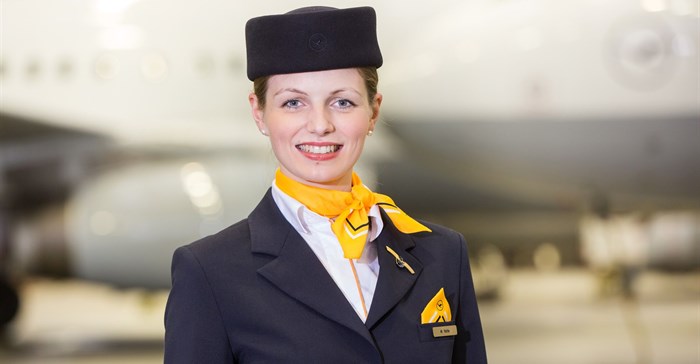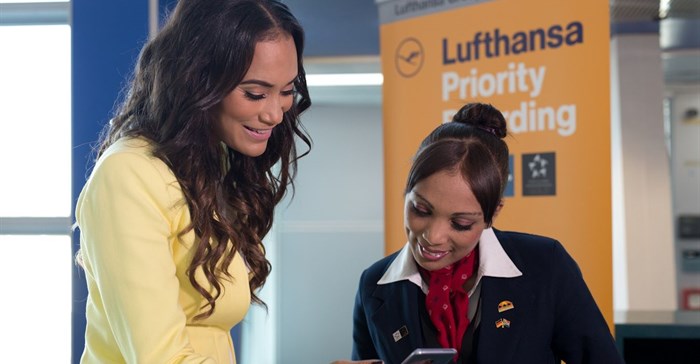Lufthansa Airlines dispel female flight attendant misconceptions

What training does a flight attendant go through?
We have an initial twelve-week training process – during this time, we experience different aspects of the job as a flight attendant. We have emergency, first aid, intercultural competencies, communication, and service training. The initial training also includes three flights as a trainee, where new colleagues are allowed to fly and work for the first time with experienced flight attendants.
How often do flight attendants have to go through training?
All Lufthansa flight attendants have to re-visit training classes every year to makes sure that they keep the highest standards. I attend these classes at the Lufthansa Aviation Training centre several times a year. It depends on the training you have to pass, but it takes anywhere between half a day to two days. For the first aid and emergency training of the different aircraft types, I have to go through a 'so-called' recurrent-training every year. For example, I’m allowed to fly on the Airbus A320, A340 and A380 – I have to go through a half day recurrent training every year for each aircraft type. In addition to this, I have to go on an emergency CRM (Crew Resource Management) Training and Security. Basically, a Lufthansa flight attendant on a full-time contract is required to pass at least six training sessions a year.
What are flight attendants trained in, in terms of safety emergency situations, both plane and people related?
You have to imagine that in the case of an emergency, we would basically be on our own. That’s the reason why we are trained to react accordingly in different states of emergency including the build-up of smoke, fire on board, the handling of dangerous goods, a bomb threat, and medical incidents. Although situations like these happen very rarely, we are trained on procedures on de-escalation in order to be fully prepared for any situation. Safety is our number-one priority.
What is the primary onboard role as a flight attendant? What does this role entail?
Our fundamental task is the safety on board, but we are also responsible for providing passengers with great service, and ultimately ensuring our guests have a relaxing flight. We are, therefore, required to fulfil different roles on board, and if necessary, we are able to switch between these roles immediately. For example, if you are in the middle of serving passengers and a medical incident occurs you would have to interrupt the service right away to assist the medical situation.
What are the common traveller misconceptions about the role of a flight attendant?
Fortunately, we don’t have medical or emergency incidents very often, so it’s understandable that some guests think the main role of a flight attendant is to provide great service. Although our number one priority is safety, we can be happy that they think we are service staff because it means they haven’t experienced an unpleasant situation on board. Of course, we do our best to also offer our guests a smooth and relaxing flight. However, this is also the reason why some guests are oblivious to our responsibility for providing safety. The service is an important part of our job, but safety is always our number-one priority.
Is it true that flight attendants get to travel for free around the world?
This is just a myth, every airline is different though. Lufthansa staff do receive certain employee discounts, but no, we cannot travel for free.
How true is it that flight attendants don’t get jet lag?
Well, we are human like everyone else, so we also have to fight against jet lag. Maybe it’s a little bit easier for us because we travel more often but even frequent travellers are good at handling jet lag. I think the more you travel, the better you know your body and after a while, you know what to do and how you sleep to try to avoid jet lag or reduce it to a minimum. Basically, everybody has his or her own way of handling it. I personally have a kind of '12 o’clock-rule'. When I arrive in the morning, I go to bed approximately until noon. It’s like a midday sleep, but it’s really important to get up after a few hours in order to arrive home and adjust to the local time. When I arrive in the afternoon, I try to keep myself awake and go to bed early in the evening.
Frequent flyer input
Jo-Ann Strauss, former Miss South Africa, businesswoman, proud mom, and the face of Lufthansa in South Africa, travels quite a bit and explains that, in her experience, the role of the flight attendant is vital, and one that should always be respected.

“In my travels as Miss South Africa, a mom, and a business person, I have experienced first-hand the assistance and guidance the flight attendants provide. While some may think that they are just there to cater to their whims and wishes, the flight attendants perform vitally important functions that go on behind-the-scenes and sometimes functions that we should be thankful that we are not aware of.
From ensuring our safety and security on board to assisting passengers who are experiencing difficulties in flight, and also having to be a little tougher when it comes to passengers whose behaviour threatens both the safety and enjoyability of the flight experience of others, the flight attendant must always be respected. They are there, first and foremost, for your safety. The fact that they can do this with a smile at 35,000 feet going at a speed of between 8 and 9 March 2017, in a highly pressurised cabin, for often more than 10 hours at a time with little to no sleep, should be enough for travellers to realise that they are simply extraordinary,” said Strauss.








